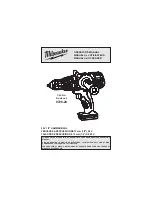
GBR
- 16 -
First release the additional handle clamp. You can
then swing the additional handle (6) into the most
comfortable working position for you. Now turn
the additional handle in the opposite direction
again until the additional handle is secure.
5.2 Depth stop (Fig. 3 – Item 7)
The depth stop (7) is held in place with the lo-
cking screw (a) on the additional handle (6) by
means of a clamp.
•
Undo the locking screw (a) and fit the depth
stop (7).
•
Set the depth stop (7) to the same level as
the drill bit.
•
Pull the depth stop (7) back by the required
drilling depth.
•
Retighten the locking screw (a).
•
Now drill the hole until the depth stop (7) tou-
ches the workpiece.
5.3. Tool insertion (Fig. 4)
•
Clean the tool before insertion and apply a
thin coating of drill bit grease to the shaft of
the tool.
•
Pull back and hold the locking sleeve (2).
•
Insert the dust-free tool into the tool mounting
as far as it will go whilst turning it. The tool will
lock itself.
•
Check that it is properly secure by pulling the
tool.
5.4 Tool removal (Fig. 5)
Pull back and hold the locking sleeve (2) and re-
move the tool.
5.5 Dust collection device (Fig. 6)
Slide the dust collection device (a) over the drill
bit before carrying out any hammer drilling verti-
cally above your head.
6. Operation
Important.
To prevent all danger, the machine must only
be held using the two handles (6/8).
Otherwise
there may be a risk of su
ff
ering an electric shock
if you drill into cables.
6.1 Status indicator (Fig. 1/Item 9)
The status indicator (9) lights up when the power
plug is connected.
6.2 Switching on and o
ff
(Fig. 1)
To switch on:
Press the control switch (4).
To switch o
ff
:
Release the control switch (4).
6.3 Speed controller (Fig. 1/Item 5)
You can use the speed controller (5) to pre-select
the required speed of rotation and blow rate. Turn
the speed controller (5) in the PLUS direction to
increase the speed of rotation and blow rate, or
turn the speed controller in the MINUS direction
to reduce the speed of rotation and blow rate.
The most suitable speed of rotation and blow rate
depend on the particular material and working
conditions.
6.4 Rotation stop facility (Fig. 7)
•
For hammer drilling, press the button (E) on
the rotary switch (3) and simultaneously turn
the rotary switch (3) to position A.
•
For chiseling, press the button (E) on the rota-
ry switch (3) and simultaneously turn the rota-
ry switch (3) to position B. In switch position B
the chisel is not locked.
•
For chiseling, press the button (E) on the
rotary switch (3) and simultaneously turn the
rotary switch (3) to position C. The chisel is
locked in position C.
Important.
Only low pressure is required for hammer drilling.
Excessive pressure will exert an unnecessary
force on the motor. Check the drill bits at regular
intervals. Sharpen or replace blunt drill bits.
Anleitung_A_BH_1200_Max_SPK7.indb 16
Anleitung_A_BH_1200_Max_SPK7.indb 16
15.03.12 09:37
15.03.12 09:37
















































